On Tuesday, the Port of Los Angeles, the United States’ busiest port and a hub for Chinese imports, said February’s TEU volumes decreased 22.9% compared to last year to 544,037 TEUs.
Imports in February decreased 22.5% to 270,025 TEUs compared to the previous year, while exports also decreased 5.7% to 134,468 TEUs. Empty containers marked a decline of 35%, falling to 139,544 TEUs.
In total, container volumes have fallen 13% in the first two months of 2020, hitting 1,350,181 TEUs.
“While cargo volumes are important, the coronavirus is first and foremost a public health crisis that needs to be brought under control with the collaboration of governments and medical experts from around the world,” said Port of Los Angeles Executive Director Gene Seroka. “We are more interconnected than ever with our global partners so it’s no surprise that Trans-Pacific maritime trade has been significantly impacted.”
Declines are expected to continue into March.
“As factory production in China remains at low levels, we expect soft volumes in March. Looking ahead to anticipated manufacturing improvements, we will need to return empty containers to Asia and push lingering U.S. export boxes out swiftly,” Seroka added. “We’re actively working with our supply chain partners to be prepared for a cargo surge once production levels ramp up.”
In 2019, the Port of Los Angeles moved a total of 9,337,632 TEUs in calendar, just shy of the port’s second-busiest year (2017) in its 113-year history and 1.28% off 2018’s record-setting volumes.
The novel coronavirus, named COVID-19, originated in Wuhan, China in December and hit its peak right around the Chinese New Year, forcing longer-than-expected shutdowns of Chinese factories. Although activity has been slowly returning to normal there, confirmed cases of COVID-19 worldwide now surpass 100,000 in more than 100 countries, according to the World Health Organization.
The U.S.-based National Retail Federation warns that the coronavirus’ impact on imports are expected to be larger and longer than previously thought as factory shutdowns and travel restrictions in China continue to affect production.
“There are still a lot of unknowns to fully determine the impact of the coronavirus on the supply chain,” NRF Vice President for Supply Chain and Customs Policy Jonathan Gold said. “As factories in China continue to come back online, products are now flowing again. But there are still issues affecting cargo movement, including the availability of truck drivers to move cargo to Chinese ports. Retailers are working with both their suppliers and transportation providers to find paths forward to minimize disruption.”

